The use of glass in architecture has never been more popular, but the global drive to increase the energy efficiency and sustainability of buildings is posing a challenge to architects, engineers and manufactures alike. Professor James O’Callaghan is pushing the boundaries to ensure the future of architectural glass.
As founding director of award-winning engineering design practice Eckersley O’Callaghan, James O’Callaghan is well-known in the world of architecture and structural engineering, but even those outside it will be familiar with his work: he is the engineer behind Apple’s iconic glass stores. “Working with the architects and team at Apple, I was the instigator in making glass a fundamental material in the pallet of their design”, he says. “I was already working with structural glass at the time, and not a lot of people were, so I knew what the potential could be.” Architecturally, that is all about transparency. “Making something out of transparent material dematerializes that object and creates a feeling of space.”
Glass staircases
His first project for Apple was a glass staircase for the company’s store in SoHo, New York. “It enhanced the customers’ ability to visually navigate the merchandise in a small retail space”, O’Callaghan explains. “From there we moved to glass bridges to building envelopes and to entire buildings. It evolved from being about transparency alone to being about what we could do with the material; how it could be integrated with architecture, to support or even create it. Though at the time I started developing Apple stores, I had no idea it would end up being such an ambitious campaign, spanning more than 400 locations.” Among them are the famous glass cube at Apple’s Fifth Avenue retail space in New York and the column-free Steve Jobs Theater on the Apple campus in Cupertino, California. Though glass has never been O’Callaghan’s sole area of work, Apple’s interest was instrumental in creating opportunities to develop a knowledge base in the material. “It has stimulated more ambitious design and fabrication technology, as well as a more ambitious use of the materials that are complementary to glass, such as the interlayers and the technology around it. In short, it has enabled the technology of structural glass to accelerate at a pace it would not have been able to otherwise”, he says.
Bridge to architects
Working closely together with architects has been vital to achieve this. “I am the bridge between the aspirations and ambitions of architects and reality. My job is to inspire them how they can use a material like glass in a creative fashion”, O’Callaghan says. “However, an architect’s ideas are often fragile, and fragile ideas are easily squashed if you don’t find ways of making them happen. So I feel I have a responsibility to be as supportive as I can; to not say ‘it can’t be done’, but rather to find ways to make them happen. Not enough engineers do that.” He believes this ‘can-do’ attitude has been behind the success of his company, which has grown from a few people in 2004 to 120 people and seven offices around the world. “It is part of our practice’s culture. A keen interest in architecture is key for everyone who works with us. Other than that, it is all about innovation. In order to keep providing creative solutions in engineering, you need to invest in R&D. We have to provide the best solutions possible with existing technology; at the same time, we have to look forward and develop technology that can address new challenges down the line. So everyone at Eckersley O’Callaghan undertakes research as a regular part of their job.”
Coming to Delft
It was this research that first brought him into contact with TU Delft, where he has been a visiting professor since 2015. In 2019 he was appointed full professor in architectural glass. “The university provides a network of people and knowledge that allows me to experiment further and deeper with the development of glass in architecture than I would have been otherwise able to do in my practice”, O’Callaghan says. “It also gives me the freedom to focus on a particular area of research without the limitations that running a business brings, so in many ways it is complementary to what I do in the commercial world. At the same time, my commercial experience can help guide the research we do here, so that the outcomes of that research have an industrial and commercial relevance in the world of architectural glass.”
Wider remit
O’Callaghan stresses that as a professor of architectural glass, his remit goes beyond glass structures. “My chair is about the future of glass in the built environment in every form. That includes glass structures, glass as part of the building envelope, but also, for example, the use of smart glass.” The overarching research questions are all about sustainability. “How can we improve the circularity of glass, so we don’t have to keep making it anew. How can we use less glass by making it thinner with the same strength? And how can we make glass contribute more to the sustainable performance of buildings?”, he sums up. For the latter challenge, the technology is out there: “There is glass that can change dynamically with its environment, to modulate light and to harvest energy through solar cells inside it. Ultimately, it will also become our screens, making separate televisions superfluous.”
Reuse, reduce, recycle
Glass in its basic form is eminently recyclable; it is what happens during post-processing that makes it less so. “We laminate glass panels, make it into double glazing units and so on. All that has an effect on the embodied carbon, and on the sustainable nature of the glass. This is something we have to address. We need to look at the way in which we design windows, and frames and building envelopes, so we can reuse glass in the future. If buildings last for fifty years, glass can last for hundreds of years.” says O’Callaghan. “An interesting research direction here is the use of digitally fabricated connecting elements.”
O’Callaghan is also setting up a dedicated glass research lab, partly funded by alumni donations. The lab will include a 4K digital microscope. “That will allow us to look at surface flaws with the resolution we need to increase our understanding of how the quality effects the strength of glass. Traditionally, the design of glass relies on fairly conservative safety factors. If we have more knowledge about the inherent flaws in glass, and how these influence performance, we may be able to reduce the safety factors and hence reduce the material we use. Ultimately, sustainability is about using less.”
Currently, only five percent of glass from buildings is recycled, compared to 90 percent of our bottles. “Even that small percentage is down-cycled. It gets used as aggregate for road building, for example.” Two researchers, Telesilla Bristogianni and Faidra Oikonomopoulou, are working on cast glass. A well-known example is The Crystal Houses in Amsterdam, built from glass bricks in 2016. “These glass bricks are made by casting molten glass, rather than processing it. This has led to the idea that you could take any form of polluted glass, from microwave doors to car windscreens, and distil it into building blocks. They are now investigating what effect that has on transparency, colour and usability. I think that is a great story of sustainability.”
Teaching
In between his busy research and business schedule, O’Callaghan also finds time to teach and mentor students, something he is passionate about. “I love the contact with students. Their minds are not filled with 30 years’ experience, so they can think in any direction they wish, and through that freedom comes creativity. Though it makes me a tad jealous that I am not that creative anymore, it also inspires me to new ideas. I hope that is a two-way street, where they in turn learn from my experience”, he says. “Ultimately, we are teaching them to become less creative along the way. We have to, because as young professionals they will need some wisdom, knowledge and experience too. But working with students is a wonderful reminder of what you found fascinating in your profession in the first place, and that reminder is an important catalyst for doing creative work.”
Looking back
His work has won him many accolades: O’Callaghan is a Fellow of the UK’s Royal Academy of Engineering, and in 2019 he was awarded the Gold Medal from the Institution of Structural Engineers, to name but a few. Looking back, his work for Apple is the body of work he is most proud of. “I look at it as a story of the evolution of structural glass over the past fifteen to twenty years. There are buildings in it I particularly like, such as the Steve Jobs theatre, which is probably the most ambitious glass structure ever built, and the culmination of many years of experimentation through other buildings.”
It is not something he would have believed possible 25 years ago. “When my boss at that time said that we were going to build with glass, I thought it was crazy. Then I got into the science of it and I started questioning things, and as a result I found all sorts of interesting aspects. That curiosity is a fundamental part of being an engineer. I was curious about glass and it has proven to be an incredibly interesting material to build with.”





